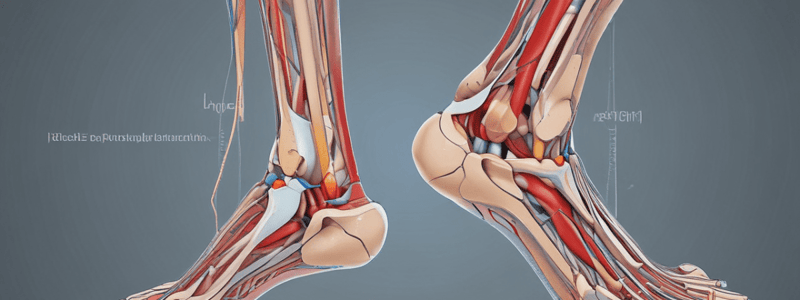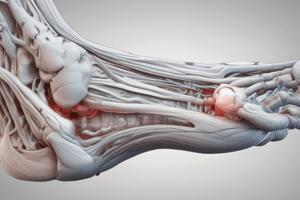Podcast
Questions and Answers
What is the range of motion for Dorsiflexion in the talocrural joint?
What is the range of motion for Dorsiflexion in the talocrural joint?
- 0-50dg
- 0-40dg
- 0-10dg
- 0-20/30dg (correct)
Which bones form the talocrural joint?
Which bones form the talocrural joint?
- Tibia, talus, and navicular
- Fibula, talus, and cuboid
- Tibia, fibula, and talus (correct)
- Tibia, fibula, and calcaneus
What is the rest position of the talocrural joint?
What is the rest position of the talocrural joint?
- 10° plantar flexion (correct)
- 10° dorsiflexion
- 20° plantar flexion
- 20° dorsiflexion
During plantar flexion in an open kinetic chain, what occurs in the talocrural joint?
During plantar flexion in an open kinetic chain, what occurs in the talocrural joint?
Which bones are included in the midfoot?
Which bones are included in the midfoot?
What is the shape of the mortise in the talocrural joint?
What is the shape of the mortise in the talocrural joint?
During dorsiflexion in a closed kinetic chain, what occurs in the talocrural joint?
During dorsiflexion in a closed kinetic chain, what occurs in the talocrural joint?
What is the name of the joint that connects the tibia and fibula?
What is the name of the joint that connects the tibia and fibula?
What type of roll and glide does the talus exhibit during dorsiflexion in the closed kinetic chain?
What type of roll and glide does the talus exhibit during dorsiflexion in the closed kinetic chain?
Which ligaments provide medial stability to the talocrural joint?
Which ligaments provide medial stability to the talocrural joint?
What is the direction of the glide of the talus during plantarflexion in the open kinetic chain?
What is the direction of the glide of the talus during plantarflexion in the open kinetic chain?
Which muscle is a dynamic stabilizer of the talocrural joint and also assists in dorsiflexion?
Which muscle is a dynamic stabilizer of the talocrural joint and also assists in dorsiflexion?
What is the shape of the mortise and talus that contributes to static stability of the talocrural joint?
What is the shape of the mortise and talus that contributes to static stability of the talocrural joint?
In which position is the talocrural joint less stable?
In which position is the talocrural joint less stable?
What type of joint is the proximal tibiofibular joint?
What type of joint is the proximal tibiofibular joint?
During dorsiflexion of the ankle, what type of gliding motion occurs in the proximal tibiofibular joint?
During dorsiflexion of the ankle, what type of gliding motion occurs in the proximal tibiofibular joint?
What is the primary function of the ankle and foot during weight-bearing activities?
What is the primary function of the ankle and foot during weight-bearing activities?
What is the shape of the trochlea of the talus?
What is the shape of the trochlea of the talus?
What type of tissue connects the tibia and fibula in the distal tibiofibular joint?
What type of tissue connects the tibia and fibula in the distal tibiofibular joint?
During knee extension, what type of gliding motion occurs in the proximal tibiofibular joint?
During knee extension, what type of gliding motion occurs in the proximal tibiofibular joint?
What is the function of the ankle and foot during propulsion and power generation?
What is the function of the ankle and foot during propulsion and power generation?
What is the structure that connects the head of the fibula with the posterolateral aspect of the tibia?
What is the structure that connects the head of the fibula with the posterolateral aspect of the tibia?
Flashcards are hidden until you start studying
Study Notes
Introduction to Biomechanics of the Ankle and Foot
- The ankle and foot provide a stable base while conforming to uneven surfaces
- They provide balance and stability, and are flexible to absorb stress and adapt to the ground
- They are also rigid to withstand propulsive forces and push off
Functions of the Ankle and Foot
- They provide important protective and feedback measures to the muscles of the lower extremity
- They enable weight bearing during walking, running, and standing
- They facilitate propulsion and power generation
- They allow positioning of the foot
Tibiofibular Joints
- The proximal tibiofibular joint (PTFJ) is a plane joint between the head of the fibula and the posterolateral aspect of the tibia
- The distal tibiofibular joint (DTFJ) is a syndesmosis between the concave face of the tibia and the convex face of the fibula
- The PTFJ has anterior and posterior proximal tibiofibular ligaments, and an interosseous membrane
- The DTFJ has anterior and posterior distal tibiofibular ligaments, and fibrous fat tissue connecting the tibia and fibula
Arthrokinematics of the Tibiofibular Joints
- The PTFJ has a slight gliding motion during osteokinematics of the ankle and knee
- Dorsiflexion and plantar flexion of the ankle cause a cranial and caudal glide, respectively
- Knee flexion and extension cause a forward and posterior glide, respectively
- The DTFJ has a separation and approximation during dorsiflexion and plantar flexion, respectively
Anatomy of the Ankle and Foot
- The ankle is a talocrural joint composed of the tibia, fibula, and talus
- The foot is composed of all tarsal bones and joints distal to the ankle
- The rearfoot includes the talus, calcaneus, and subtalar joint
- The midfoot includes the navicular, cuboid, and three cuneiforms
- The forefoot includes the metatarsals and phalanges, including all distal joints and the tarsometatarsal joints
Talocrural Joint
- The talocrural joint is a hinge joint with one degree of freedom
- The rest position is 10° of plantar flexion
- The compact position is achieved through maximal dorsiflexion
- The concave/convex rule applies to the joint: open kinetic chain (OKC) follows the convex rule, and closed kinetic chain (CKC) follows the concave rule
Osteokinematics of the Talocrural Joint
- The range of motion is 0-20/30° of dorsiflexion and 0-50° of plantar flexion
Arthrokinematics of the Talocrural Joint
- Dorsiflexion and plantar flexion have different arthrokinematic patterns in OKC and CKC
- In OKC, dorsiflexion involves a posterior slide and anterior roll of the talus, and plantar flexion involves an anterior slide and posterior roll
- In CKC, dorsiflexion involves an anterior slide and anterior roll of the mortise, and plantar flexion involves a posterior slide and posterior roll
Talocrural Joint Stability
- Static stabilizers include the mortise and talar shape, gravity, capsule, and ligaments
- Dynamic stabilizers include the musculature
- Medial stability is provided by the deltoid ligament, which includes the tibionavicular, tibiotalar, and tibiocalcaneus ligaments
- Lateral stability is provided by the anterior talofibular ligament, posterior talofibular ligament, and calcaneofibular ligament
Kinetics of Dorsiflexion and Plantarflexion
- Dorsiflexion is primarily achieved by the tibialis anterior muscle
- Plantar flexion is primarily achieved by the gastrocnemius muscle
- The ankle is less stable in plantar flexion
Studying That Suits You
Use AI to generate personalized quizzes and flashcards to suit your learning preferences.




